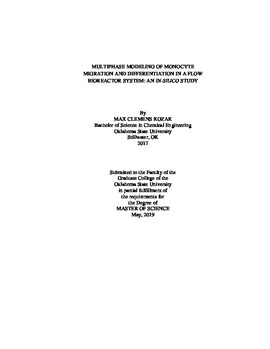| dc.contributor.advisor | Feng, Yu | |
| dc.contributor.author | Kozak, Max Clemens | |
| dc.date.accessioned | 2019-10-25T20:25:28Z | |
| dc.date.available | 2019-10-25T20:25:28Z | |
| dc.date.issued | 2019-05-01 | |
| dc.identifier.uri | https://hdl.handle.net/11244/321627 | |
| dc.description.abstract | The objective of this study was to model monocyte migration and differentiation into dendritic cells under a variety of conditions in a novel designed plate bioreactor with flow using Computational Fluid Dynamics (CFD) simulation software. The model was developed to study fluid flow phenomena throughout the geometry such as shear rate patterns and velocity streamlines that can be expected over a range of parameters. Additionally, monocyte and dendritic cell concentrations were predicted for the same conditions to provide insight for actual experimental conditions and make recommendations for an optimal setup. To model the endothelial cell layer that was cultured in the plate bioreactor during experiments, this region of the bioreactor was set up in the model as a porous media with viscous and inertial resistance calculated based on cell properties and porosity of the layer. Using preliminary experimental data for the plate bioreactor, a monocyte death rate correlation was developed as a function of local shear rate and a first-order kinetics reaction correlation was developed to describe the differentiation of monocytes into dendritic cells. These correlations were incorporated into the developed model in the form of User-Defined Functions (UDFs) so that cell concentrations could be monitored over the duration of actual experimental time. The plate bioreactor was simulated for 48 hours at an inlet Reynolds number (Rein) ranging from 2.5 to 25 and inlet monocyte concentration ranging from 250,000 cells/mL to 1,000,000 cells/mL. Concentrations of both monocytes and dendritic cells were greatly affected by the changing of Rein. Results showed that a Rein of 5.0 provides the most optimal conditions in an experimental setting. As Rein increases beyond 5.0, it is predicted that the number of still living monocytes and differentiated dendritic cells will greatly decrease in a 48-hour experiment. Simulation results were validated by measuring monocyte and dendritic cell concentrations over a range of Rein tested experimentally and recommendations were made for potential future works. | |
| dc.format | application/pdf | |
| dc.language | en_US | |
| dc.rights | Copyright is held by the author who has granted the Oklahoma State University Library the non-exclusive right to share this material in its institutional repository. Contact Digital Library Services at lib-dls@okstate.edu or 405-744-9161 for the permission policy on the use, reproduction or distribution of this material. | |
| dc.title | Multiphase Modeling of Monocyte Migration and Differentiation in a Flow Bioreactor System: An In-Silico Study | |
| dc.contributor.committeeMember | Fahlenkamp, Heather | |
| dc.contributor.committeeMember | Ramsey, Joshua D. | |
| osu.filename | Kozak_okstate_0664M_16247.pdf | |
| osu.accesstype | Open Access | |
| dc.type.genre | Thesis | |
| dc.type.material | Text | |
| dc.subject.keywords | bioreactor | |
| dc.subject.keywords | computational fluid dynamics | |
| dc.subject.keywords | tissue engineering | |
| thesis.degree.discipline | Chemical Engineering | |
| thesis.degree.grantor | Oklahoma State University | |
